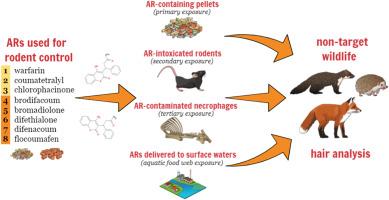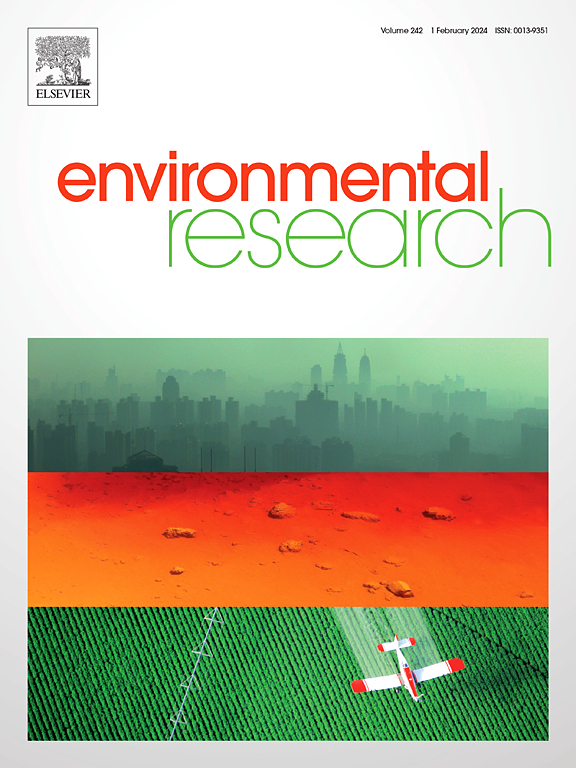First evidence of the suitability of hair for assessing wildlife exposure to anticoagulant rodenticides (ARs)
IF 7.7
2区 环境科学与生态学
Q1 ENVIRONMENTAL SCIENCES
引用次数: 0
Abstract
Anticoagulant rodenticides (ARs) are potent pesticides acting as vitamin K epoxide reductase inhibitors causing haemorrhaging or external bleeding from orifices and/or skin lesions in intoxicated rodents. However, their non-selective mode of action makes them particularly harmful for non-target wildlife, which may be exposed to ARs via ingestion of AR-containing baits (primary exposure), feeding on AR-intoxicated rodents and carrions (secondary exposure), consuming AR-contaminated necrophagous species (tertiary exposure), and exposure to surface waters receiving baited sewer systems and ARs from outdoor-placed traps after heavy rain events. In the present study, we assessed the suitability of hairs as a non-invasive matrix for monitoring the possible exposure of mammals to ARs with a focus on the first-generation anticoagulant rodenticides (FGARs) warfarin, coumatetralyl, and chlorophacinone and the second-generation anticoagulant rodenticides (SGARs) brodifacoum, bromadiolone, difenacoum, flocoumafen, and difethialone. The Red fox (n = 24) was selected as the species representing the potentially exposed non-target wildlife in a littoral area of Northern Italy along the Adriatic coast (Cavallino-Treporti municipality). Half (n = 12) of the analysed hair samples were positive for at least one of the targeted ARs, with a higher prevalence of SGARs (n = 11; 46%) compared to FGARs (n = 1; 4%). The most frequently quantified ARs were brodifacoum (25%), difethialone (13%), and flocoumafen (13%), with concentrations ranging from 0.08 ng g−1 (difethialone) to 0.96 ng g−1 (brodifacoum). These data documented that a relevant part of the Red foxes living in the study area were exposed to ARs and, most importantly, provided the first evidence that hair residues can be used as a non-invasive matrix for assessing the possible exposure of mammals to ARs.

首次证明毛发适用于评估野生动物接触抗凝血灭鼠剂 (ARs)的情况。
抗凝血灭鼠剂(ARs)是一种强效杀虫剂,作为维生素 K 环氧化物还原酶抑制剂,可导致中毒啮齿动物大出血或口腔和/或皮肤损伤。然而,它们的非选择性作用模式使其对非目标野生动物特别有害,这些野生动物可能会通过摄入含有 AR 的毒饵(一次接触)、捕食受 AR 污染的啮齿动物和腐肉(二次接触)、食用受 AR 污染的腐尸物种(三次接触),以及在暴雨后接触到接收毒饵下水道系统的地表水和室外放置的诱捕器中的 AR。在本研究中,我们评估了毛发作为非侵入性基质监测哺乳动物可能暴露于抗逆转录病毒药物的适宜性,重点是第一代抗凝血灭鼠剂(FGARs)华法林、库马替雷和氯鼠酮,以及第二代抗凝血灭鼠剂(SGARs)溴敌鼠、溴敌隆、鼠得克、氟虫螨脲和鼠得克。红狐(n = 24)被选为意大利北部亚得里亚海沿岸地区(Cavallino-Treporti 市)可能接触到的非目标野生动物的代表物种。分析的毛发样本中有一半(n = 12)至少对一种目标 AR 呈阳性,与 FGAR(n = 1;4%)相比,SGAR 的发生率更高(n = 11;46%)。最常定量的抗原是溴敌隆(25%)、地芬酮(13%)和氟虫酰胺(13%),浓度范围为 0.08 纳克/克-1(地芬酮)至 0.96 纳克/克-1(溴敌隆)。这些数据表明,生活在研究区域内的红狐有相当一部分接触了抗逆转录病毒药物,最重要的是,这些数据首次证明了毛发残留物可用作评估哺乳动物可能接触抗逆转录病毒药物的非侵入性基质。
本文章由计算机程序翻译,如有差异,请以英文原文为准。
求助全文
约1分钟内获得全文
求助全文
来源期刊

Environmental Research
环境科学-公共卫生、环境卫生与职业卫生
CiteScore
12.60
自引率
8.40%
发文量
2480
审稿时长
4.7 months
期刊介绍:
The Environmental Research journal presents a broad range of interdisciplinary research, focused on addressing worldwide environmental concerns and featuring innovative findings. Our publication strives to explore relevant anthropogenic issues across various environmental sectors, showcasing practical applications in real-life settings.
 求助内容:
求助内容: 应助结果提醒方式:
应助结果提醒方式:


